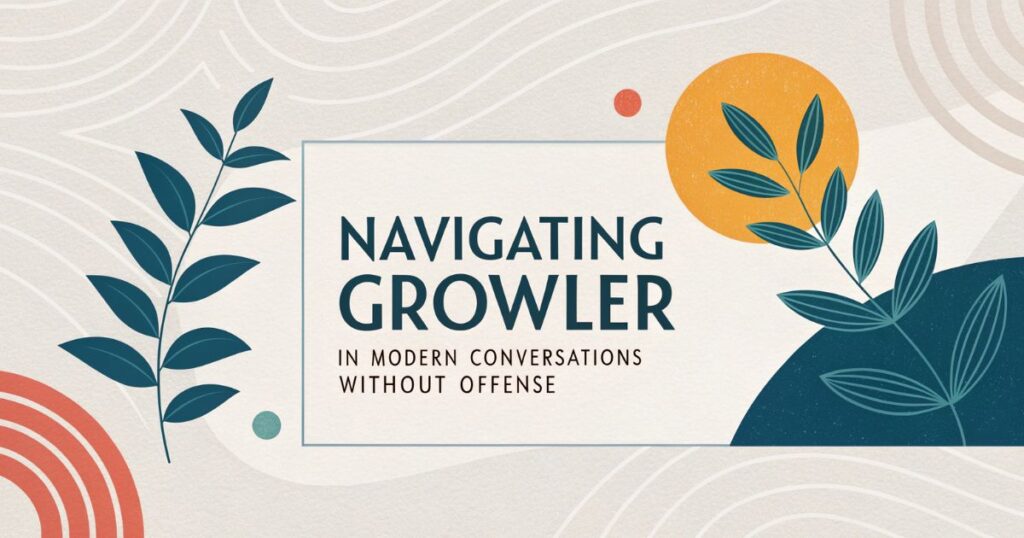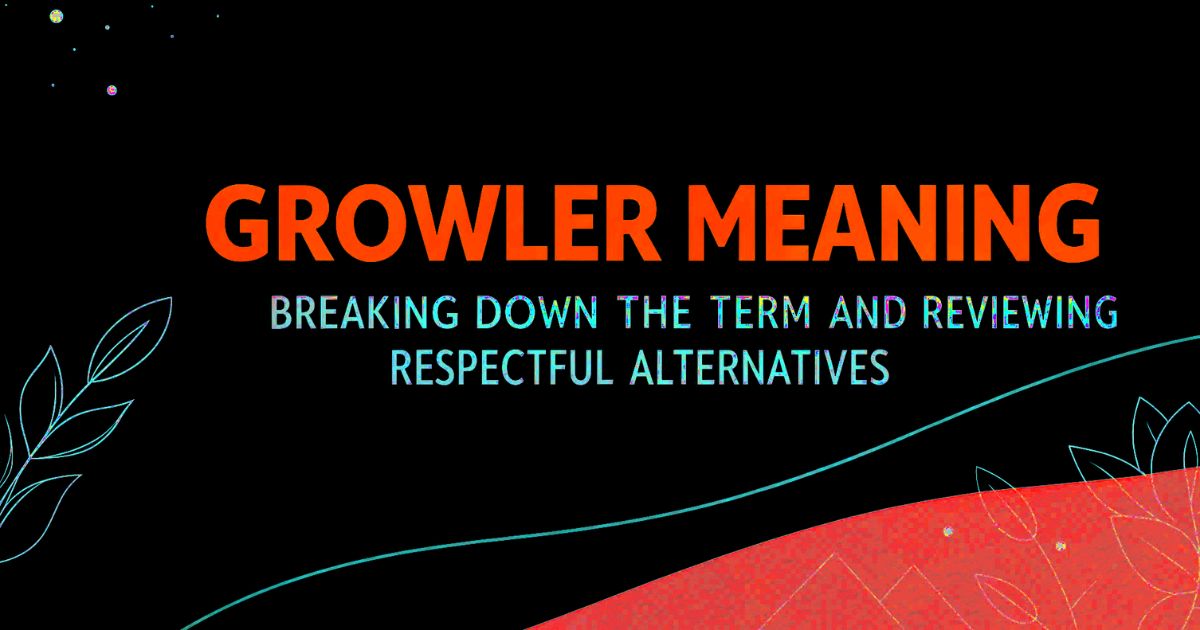You’ve probably heard the word “growler” tossed around in conversations, but understanding its various meanings can save you from awkward misunderstandings.
This term carries multiple definitions across different cultures and contexts, making it essential to know when and how to use it appropriately.
Let’s explore the complete picture behind this surprisingly complex word and discover better alternatives for clear communication.
What Does Growler Actually Mean? Understanding Multiple Definitions
The word “growler” operates like a linguistic chameleon, shifting meanings depending on your location and context. In American craft beer culture, it specifically refers to a 64-ounce glass or ceramic container used to transport draft beer from breweries to your home.
However, venture across the Atlantic, and you’ll discover that British slang uses “growler” as a vulgar reference to female anatomy. This creates immediate communication challenges for international beer enthusiasts who might innocently discuss their favorite brewery’s growler selection.
Australian and New Zealand English adds another layer of complexity. Down under, a “growler” often describes a taxi cab or sometimes refers to an iceberg. Regional variations multiply the potential for confusion.
The maritime world contributes yet another definition. Sailors historically used “growler” to describe small icebergs that posed navigation hazards. These floating ice chunks would make distinctive growling sounds as waves crashed against them.
Understanding these multiple meanings becomes crucial for effective communication. Context determines everything when using this term, and awareness prevents embarrassing miscommunications in professional or social settings.
The Etymology Behind Growler
The beer-related “growler” originated in the 1880s American working-class culture. Factory workers would bring metal pails or buckets to local saloons during lunch breaks to purchase fresh beer for take-home consumption.
The name emerged from a practical acoustic phenomenon. When carbon dioxide escaped from fresh beer in these metal containers, it created a distinctive growling sound. This auditory signature became so recognizable that patrons would literally hear their beer “growling” during transport.
German-American brewers in cities like Milwaukee, Cincinnati, and St. Louis popularized the practice. These communities valued fresh, unpasteurized beer and needed reliable methods to transport draft beer before refrigeration became widespread.
The term gained legitimacy through repeated usage in brewing publications from the 1890s onward. Trade magazines and brewing industry journals documented growler fills as standard practice across American breweries.
Prohibition temporarily eliminated growler culture between 1920-1933. However, the term survived in brewing communities and experienced a massive renaissance during the craft beer boom starting in the 1980s.
Modern etymology traces show the word spread through oral tradition rather than written documentation. This explains why regional variations developed independently across different English-speaking countries.
Navigating Growler in Modern Conversations Without Offense

Context awareness becomes your most valuable tool when discussing growlers. In brewery settings, taprooms, and craft beer communities, the term enjoys widespread acceptance and understanding as beer terminology.
Professional environments require heightened sensitivity. International business calls, corporate presentations, and formal correspondence should avoid ambiguous slang terms that might cause confusion or offense.
Age-appropriate considerations matter significantly. Elementary school brewing history lessons might benefit from alternative terminology, while college-level hospitality courses can address the term’s multiple meanings directly.
Reading social cues helps determine appropriate usage. If your audience includes international colleagues, elderly relatives, or mixed-gender professional groups, consider using clearer alternatives.
Geographic awareness proves essential for travelers. American craft beer enthusiasts visiting British pubs should recognize that requesting growler fills might generate unexpected reactions or misunderstandings.
Digital communication platforms present unique challenges. Social media posts, forum discussions, and online reviews should consider diverse audiences who might interpret the term differently.
When Growler References Are Welcome and Appropriate
Brewery taprooms represent the natural habitat for growler terminology. Staff, customers, and enthusiasts use the term freely without confusion or concern about alternative meanings.
Beer festivals and craft brewing events create safe spaces for growler discussions. These environments attract knowledgeable audiences who understand brewing terminology and appreciate historical context.
Homebrewing communities embrace growler references as part of their technical vocabulary. Online forums, brewing clubs, and equipment discussions regularly feature growler-related content without controversy.
Industry publications and trade magazines use “growler” as standard terminology. Beer & Brewing Magazine, Craft Brewing Business, and similar publications treat it as established brewing vocabulary.
Educational brewery tours incorporate growler history into their presentations. Tour guides explain the term’s origins while demonstrating proper filling techniques and storage methods.
Retail beer shops and bottle shops commonly advertise growler fill services. Customers expect this terminology when seeking fresh draft beer for off-premise consumption.
Smart Alternatives to Growler When Clarity Matters Most
“Beer jug” provides universal understanding across all English-speaking regions. This simple alternative eliminates confusion while maintaining descriptive accuracy about the container’s purpose.
“64-ounce bottle” offers precise measurement context. Technical discussions, international communications, and retail descriptions benefit from this specific sizing reference.
“Draft container” emphasizes the functional aspect. This phrase works particularly well in professional presentations, educational materials, and cross-cultural communications.
“Refillable beer vessel” appeals to environmentally conscious discussions. Sustainability-focused marketing and eco-friendly brewery initiatives often prefer this terminology.
Brand-specific names like “Hydro Flask beer growler” or “Stanley beer jug” provide clarity through product identification. Retail environments often benefit from these specific references.
“Take-home beer container” explains the purpose clearly. This descriptive phrase works well for newcomers to craft beer culture who might not understand traditional terminology.
How Growler Lands Across Different English-Speaking Countries
American craft beer culture has fully embraced growler terminology. Over 8,000 craft breweries across the United States offer growler fills as standard service, making the term mainstream within beer communities.
British sensitivities require careful navigation. While some progressive British craft breweries have adopted American terminology, many establishments prefer “beer bottle” or “take-away container” to avoid potential embarrassment.
Canadian regional variations follow American patterns in most provinces. British Columbia’s craft beer scene particularly embraces growler culture, while Maritime provinces sometimes prefer alternative terminology.
Australian craft brewing has selectively adopted the term. Major cities like Melbourne and Sydney feature growler-friendly breweries, though many establishments use “beer bottle” or “schooner jug” instead.
New Zealand brewing culture shows mixed adoption. Auckland and Wellington breweries often use American terminology, while smaller communities might prefer locally understood alternatives.
International business protocols generally recommend avoiding potentially ambiguous slang. Multinational brewing companies typically use “draft containers” or “beer bottles” in official communications.
Explaining Growler Appropriately in Educational Settings
Age-appropriate brewing history can include growler origins without dwelling on alternative meanings. Elementary students learn about 1800s working-class life, while high schoolers can handle more complex linguistic discussions.
Cultural literacy lessons benefit from addressing multiple word meanings. Language arts classes can explore how geographic regions develop different definitions for identical terms.
Academic etymology discussions provide rich material for linguistics courses. University-level classes can examine how industrial culture created specialized vocabulary that spread through immigration patterns.
Museum brewery exhibits often feature historical growler displays. These educational contexts allow detailed explanations of terminology evolution within appropriate historical frameworks.
Parent-child conversations about language nuance help develop communication skills. Discussing how words carry different meanings across cultures builds awareness and empathy.
Brewing science education naturally incorporates growler terminology. Culinary schools, hospitality programs, and brewing certification courses treat it as essential vocabulary.
Professional Communication: When to Avoid Growler Terminology Entirely
Corporate brewery marketing increasingly uses alternative terminology in international campaigns. Global brands like Heineken and Budweiser prefer “draft containers” or “beer bottles” in worldwide advertising.
International business correspondence benefits from unambiguous language. Export documentation, brewing equipment sales, and cross-border partnerships should use precise, culturally neutral terminology.
Educational institution policies often require sensitivity training for staff. University dining services, culinary programs, and hospitality courses may establish guidelines for appropriate terminology usage.
Customer service best practices emphasize clear communication. Phone support, email correspondence, and live chat services should prioritize understanding over industry jargon.
Legal and regulatory documents demand precision. Alcohol licensing applications, health department filings, and business permits typically use formal terminology rather than colloquial expressions.
Medical and safety communications require absolute clarity. Workplace safety training, alcohol awareness programs, and health education materials should avoid potentially confusing slang terms.
Will This Term Evolve or Fade Away?
Craft beer industry trends suggest continued growth in growler usage. The American craft brewing market reached $26.8 billion in 2022, with growler fills representing approximately 8% of off-premise sales.
Generational language preferences show interesting patterns. Millennials and Gen Z consumers readily adopt brewing terminology, while older demographics sometimes prefer descriptive alternatives.
Social media impact accelerates terminology spread. Instagram posts featuring #growler hashtags exceed 500,000 annually, indicating strong digital engagement with the term.
Corporate rebranding efforts in major brewing companies increasingly embrace craft terminology. Even macro-breweries now offer growler services to compete in the craft market segment.
Environmental consciousness drives growler popularity. Reusable containers align with sustainability values, encouraging continued usage among environmentally aware consumers.
International craft brewing expansion will likely require terminology standardization. As American-style craft breweries open globally, linguistic adaptation becomes necessary for market success.
FAQs
What does the slang term growler mean?
Growler primarily refers to a 64-ounce beer container in American English, though British slang uses it as vulgar anatomy reference. Context determines the intended meaning, making awareness crucial for appropriate usage.
Why is called a growler?
The name originated from carbon dioxide escaping fresh beer in metal containers during the 1880s, creating distinctive growling sounds. This acoustic phenomenon gave the beer transport method its memorable and practical name.
How do you use growler in a sentence?
“I’m getting my growler filled at the brewery tonight” works perfectly in American craft beer contexts. However, international communications might prefer “I’m filling my beer container” to ensure clear understanding.
Conclusion
Understanding growler’s multiple meanings empowers you to communicate effectively across different contexts and cultures.
Whether you’re discussing craft beer, navigating international conversations, or teaching others about language nuance, awareness prevents misunderstandings. Choose your terminology wisely, consider your audience carefully, and remember that clear communication always trumps insider jargon.
More Posts
Poison Tree Tattoo Meaning: A Complete Guide to Symbolism
Top 42 Goodfella Meaning: The Ultimate Guide with Clear Examples
100+ Romantic Good Morning Messages for Her to Make Her Heart Melt

Welcome to Brightnis! I am the admin and creator of this platform. I love questioning ideas and exploring different situations. My goal is to encourage critical thinking and help people see things from new perspectives. Join me in discussing thought-provoking topics and finding unique solutions to everyday challenges!






